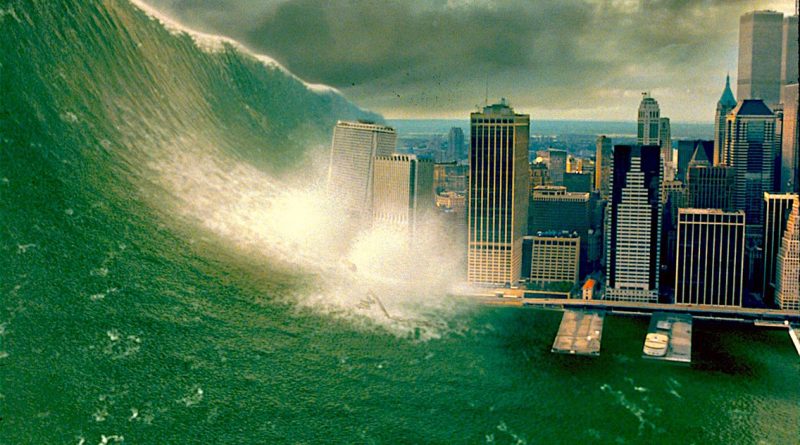Report: Putin’s nuclear ‘doomsday machine’ could trigger massive 300-foot tsunamis- Is it real?
- Vladimir Putin recently said Russia is developing a nuclear-powered torpedo that could detonate a “massive” nuclear weapon.
- Such a device might create a 300-foot-tall tsunami if exploded in the right location, and could rain long-lasting radioactive fallout on a coastal target.
- Experts have called the hypothetical weapon a “doomsday” device, since it could spread unprecedented and long-lived radioactive fallout.
- But one researcher said such a weapon “would be completely stupid,” since it’d greatly limit its damage compared to an airburst.
During Vladimir Putin’s address to the Russian Federal Assembly on March 1, he described aplethora of nuclear weapons Russia is developing.
One of these proposed weapons — an autonomous submarine — stood out among the depictions of falling warheads and nuclear-powered cruise missiles.
The autonomous drone would quietly travel to “great depths,” move faster than a submarine or boat, “have hardly any vulnerabilities for the enemy to exploit,” and “carry massive nuclear ordnance,” Putin said, according to a Kremlin translation of his remarks (PDF).
“It is really fantastic. […] There is simply nothing in the world capable of withstanding them,” he said, claiming Russia tested a nuclear-powered engine for the drones in December 2017. “Unmanned underwater vehicles can carry either conventional or nuclear warheads, which enables them to engage various targets, including aircraft groups, coastal fortifications and infrastructure.”
Putin did not refer to the device by name in his speech, but it appears to be the “oceanic multi-purpose Status-6 system” — also known as Kanyon or “Putin’s doomsday machine.”
The Russian government reportedly leaked a diagram of that weapon in 2015, which suggest it’d carry a 50-megaton nuclear bomb about as powerful as Tsar Bomba, the largest nuclear device ever detonated.
Nuclear physicists say such a weapon could cause a large local tsunami, though they question its purpose and effectiveness, given the far-more-terrible destruction that nukes can inflict when detonated above-ground.
Why Putin’s ‘doomsday machine’ could be terrifying
A nuclear weapon detonated below the ocean’s surface can cause great devastation.
The underwater US nuclear weapons tests of the 1940s and 1950s — including operations “Crossroads Baker” and “Hardtack I Wahoo” — demonstrated why.
These underwater fireballs were roughly as energetic as the bombs dropped on Hiroshima or Nagasaki in August 1945. In the tests, they burst through the surface, ejecting pillars of seawater more than a mile high while rippling out powerful shockwaves.
Some warships staged near the explosions were vaporized. Others were tossed like toys in a bathtub and sank, or sustained cracked hulls, crippled engines, and other damage. Notably, the explosions roughly doubled the height of waves to nearby islands, flooding inland areas.
“A well-placed nuclear weapon of yield in the range 20 MT to 50 MT near a seacoast could certainly couple enough energy to equal the 2011 tsunami, and perhaps much more,” Rex Richardson, a physicist and nuclear-weapons researcher, told Business Insider. The 2011 event he’s referring to is the Tohoku earthquake and tsunami that killed more than 15,000 people in Japan.
“Taking advantage of the rising-sea-floor amplification effect, tsunami waves reaching 100 meters [328 feet] in height are possible,” Richardson said.
Richardson and other experts have also pointed out that a near-shore blast from this type of weapon could suck up tons of ocean sediment, irradiate it, and rain it upon nearby areas — generating catastrophic radioactive fallout.
“Los Angeles or San Diego would be particularly vulnerable to fallout due to the prevailing on-shore winds,” Richardson wrote, adding that he lives in San Diego.
The problem with blowing up nukes underwater
Greg Spriggs, a nuclear-weapons physicist at Lawrence Livermore National Laboratory, acknowledges that a 50-megaton weapon “could possibly induce a tsunami” and hit a shoreline with the energy equivalent to a 650-kiloton blast.
But he thinks “it would be a stupid waste of a perfectly good nuclear weapon.”
That’s because Sprigg believes it’s unlikely that even the most powerful nuclear bombs could unleash a significant tsunami after being detonated underwater.
“The energy in a large nuclear weapon is but a drop in the bucket compared to the energy of a [naturally] occurring tsunami,” Spriggs previously told Business Insider. “So, any tsunami created by a nuclear weapon couldn’t be very large.”
For example, the 2011 tsunami in Japan released about 9,320,000 megatons (MT) of TNT energy. That’s hundreds of millions of times more than the bomb dropped on Hiroshima in 1945, and roughly 163,000 times greater than the Soviet Union’s test of Tsar Bomba on October 30, 1961.
Plus, Spriggs added, the energy of a blast wouldn’t all be directed toward shore — it’d radiate outward in all directions, so most of it “would be wasted going back out to sea.”
A detonation several miles from a coastline would deposit only about 1% of its energy as waves hitting the shore. That scenario may be more likely than an attack closer to the shore, assuming a US weapons-detection systems could detect an incoming Status-6 torpedo.
But even on the doorstep of a coastal city or base, Spriggs questions the purpose.
“This would produce a fraction of the damage the same 50 MT weapon could do if it were detonated above a large city,” Spriggs said. “If there is some country out there that is angry enough at the United States to use a nuclear weapon against us, why would they opt to reduce the amount of damage they impose in an attack?”
Is the Doomsday weapon real?
Putin fell short of confirming that Status-6 exists, though he did say the December 2017 tests of its power unit “enabled us to begin developing a new type of strategic weapon” to carry a huge nuclear bomb.
The Trump administration even addressed the weapon’s possible existence in its 2018 nuclear posture review.
In a 2015 article in Foreign Policy, Jeffrey Lewis — a nuclear-policy expert at the Middlebury Institute of International Studies — dubbed the weapon “Putin’s doomsday machine.”
He wrote that in part because of speculation that the underwater weapon might be “salted,” or surrounded with metals like cobalt. That would dramatically extend fatal radiation levels from fallout (possibly for years or even decades), since the burst of neutrons emitted in a nuclear blast could transform those metals into long-lived, highly radioactive chemicals that sprinkle all around.
“What sort of sick bastards dream up this kind of weapon?” Lewis wrote, noting that such “salted” weapons are featured in the Cold War parody and science-fiction movie “Dr. Strangelove, or: How I Learned to Stop Worrying and Love the Bomb.”
In Lewis’s eyes, it doesn’t necessarily matter if Status-6 is real or a psychological bluff designed to prevent the US from attacking Russia or its allies.
“Simply announcing to the world that you find this to be a reasonable approach to deterrence should be enough to mark you out as a dangerous creep,” he said.





